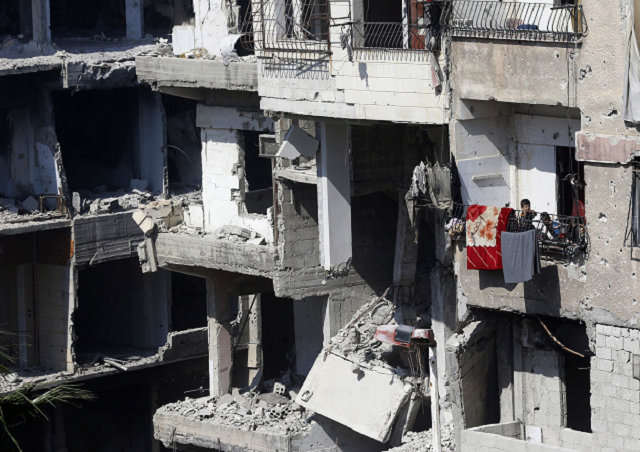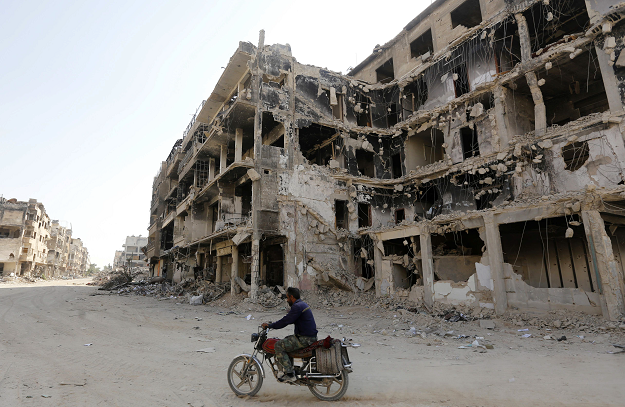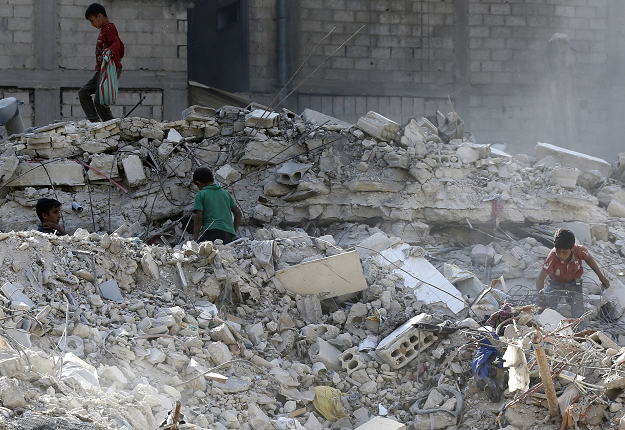
Mountains of rubble still block many of the main thoroughfares in Harasta, a town outside Damascus held for nearly five years by armed militants.
After a blistering weeks-long assault, Syria's government recaptured it in March, and displaced families have been trickling back to check if their homes survived.
 A man rides a motorbike by destroyed buildings in Harasta, on the outskirt of the Syrian capital Damascus. PHOTO: AFP.
A man rides a motorbike by destroyed buildings in Harasta, on the outskirt of the Syrian capital Damascus. PHOTO: AFP.Khaled, 35, watches them cross a security checkpoint and approaches to pitch his services: knocking down walls, clearing rubble, and sweeping up debris.
"I used to be a barber, but now I'm a labourer. I wait for families to enter and offer them my services in cleaning and restoration," he tells AFP.
Khaled fled Harasta in 2012 to the nearby town of Al Tal, where he still lives with his family. Every day, the father of three commutes to Harasta to find work.
First new steps for Syrian girl who used tin cans for legs
His own house still stands, but he cannot return yet: temporary security measures dictate that people who live outside the town cannot stay past nightfall.
"I work with three other people. We use hammers, brooms, and buckets of water. Work is on and off," he says.
"Clients pay us whatever they can afford."
Harasta lies in Eastern Ghouta, recaptured this spring by Syrian troops with a deal that saw thousands of militants and civilians bussed to opposition territory elsewhere.
Others, like 45-year-old Hassan, chose not to leave.
 Children play amid the rubble of destroyed buildings in Harasta. PHOTO: AFP.
Children play amid the rubble of destroyed buildings in Harasta. PHOTO: AFP.The former petrol station worker remained in Harasta throughout the militant reign and decided to stay in its aftermath, too.
Hassan now works with Khaled, transporting rocks and other materials in his pick-up truck to construction sites.
"This is the only work in Harasta that pays right now," says Hassan, wearing a dirty wool sweater despite the heat.
Harasta was once home to 250,000 people, most of them Syrians from elsewhere in the country who worked in the capital but sought cheap rent.
Now, just 15,000 people remain, town officials estimate, unable to leave until security forces clear their names.
With the use of personal cars banned, boys get around on bicycles while women and toddlers shuffle along on foot.
Many of Harasta's large residential blocks or industrial complexes have been pulverised by strikes, artillery, and mortars.
They stand like massive grey honeycombs overlooking dusty streets still stripped of signs of life, months after fighting has stopped.
Mohammad Naaman, 50, was terrified his home would be among those gutted by fighting--and can hardly contain himself when he finds it still standing.
"I was shocked to see most buildings collapsed. It's true my house is devastated compared to before, but I'm happy it's still there at all," says Naaman.
He, too, fled to Al Tal in 2012 and still lives there.
The doors and windows of his Harasta home have been blown out and cracks run up the walls, threatening collapse.
 A Syrian boy rides his bicycle amid the rubble of destroyed buildings being removed by a bulldozer. PHOTO: AFP.
A Syrian boy rides his bicycle amid the rubble of destroyed buildings being removed by a bulldozer. PHOTO: AFP.But in the living room, a layer of dust blankets plastic flowers still standing in their vases.
"Whatever happens, it's still my house, and my house is so dear to me," Naaman tells AFP.
US, world powers warned 'fuelling Syrian war may lead to WWIII'
Like his neighbours, Naaman's first step was removing the rubble and debris from his home, dumping them into the main street nearby according to instructions by local authorities.
Vehicles provided by the public works ministry transport the rubble to a local dump, separating metal out so that concrete can be turned back to cement and reused.
"We removed 110,000 cubic metres of rubble from the streets, but there's still more than 600,000 to go," says Adnan Wezze, who heads the town council running Harasta since the regime's recapture.
As he speaks, a demolition digger works on a two-storey building. Its metal arm reaches up to the roof and picks off slabs of concrete precariously perched there.
Authorities are working fast to demolish buildings "at risk of collapse, because they present a public safety threat," says Wezze.
Many urban hubs across Syria, particularly around Damascus, have been hard-hit by hostilities, and President Bashar al Assad said this month rebuilding would be his "top priority".
But Law 10, a recent decree which allows for the expropriation of property to redevelop an area, sparked fears that millions of displaced Syrians would not get the opportunity to make a claim to their land.
Wezze insists that Harasta's modest efforts were fair.
"We only demolish after getting permission from the owners," he tells AFP.
If they are not present, Wezze adds, "their rights are still protected. We've requested proof of property even before areas are designated as development projects."
"No resident of Harasta will lose his rights--whether they're here or in exile."


















COMMENTS
Comments are moderated and generally will be posted if they are on-topic and not abusive.
For more information, please see our Comments FAQ